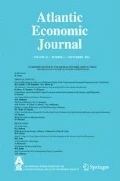Abstract
The fantasy sports industry, primarily led by fantasy football, has reportedly grown to 18 million unique players generating over $2 billion dollars annually according to the Fantasy Sports Trade Association. Anecdotal evidence suggests that this impressive growth is also generating increased interest for the sports on which the games are based. We use survey data from the ESPN Sports Poll to determine whether fantasy football participation increases NFL game attendance. The results suggest that fantasy football participants are not only more likely to attend at least one game per year, but also that they attend between 0.22 and 0.57 more games per season.
Similar content being viewed by others
Notes
See Bell (2008) at http://www.nytimes.com/2008/04/05/technology/05interview.html for further details.
For points-based leagues, points are accumulated throughout the season, and the team with the most points at the end of the year is declared the league champion.
See Prescott (2006) at http://www.imediaconnection.com/content/9599.asp for a more complete analysis of the survey.
In such a case, the NFL may opt to attempt to prevent the usage of players’ names and statistics without approval by the NFL, much like the MLB’s recent attempt which was rejected by the Supreme Court.
Schofield (1983), in his survey paper, suggests an alternative definition of the four categories: economic variables, demographic variables, expected quality of the game variables, and a fourth category composed of other relevant variables not included in the first three categories.
Welki and Zlatoper’s (1999) update to their earlier work also provides some evidence that attendance may be positively related to income.
Like the other studies discussed above, Spenner and Crooker (2004) find that the home team’s winning percentage is a statistically significant and positive influence on attendance; however, their results also indicate that both ticket price and income, while positively related to attendance, are statistically insignificant.
While not addressed in the current paper, the application of the rational addition model to fantasy sports participation is an excellent topic for future research.
Furthermore, if the procedure did bias the results, the bias would be in favor of not finding evidence that fantasy participation increases attendance. The percentage of the removed respondents who play fantasy football (17.7%) is nearly three times as large as the percentage of those in the final sample who play fantasy football (6.0%).
DMAs are regions, often encompassing at least one Metropolitan Statistical Area, in which the residents receive the same television (and other media) programming.
In regards to the playoffs and Super Bowl appearance variables for two teams within the same DMA, then we set the variable equal to one if at least one of the teams reached the playoffs or Super Bowl and zero otherwise.
The endogeneity of fantasy football participation was tested via a Wu-Hausman test with results of this test suggesting there is insufficient evidence to reject the null of weak exogeneity. As such, IV estimation is consistent but inefficient. Internet usage and fantasy baseball participation were used as instruments for NFL Fantasy for purposes of this test.
References
Bell, J. (2008). Making it to the major league of fantasy sports. The New York Times, available at http://www.nytimes.com/2008/04/05/technology/05interview.html. Accessed July 2008.
Clapp, C. M., & Hakes, J. K. (2005). How long a honeymoon? The effect of new stadiums on attendance in major league baseball. Journal of Sports Economics, 6(3), 237–263.
Coates, D., & Harrison, K. (2005). Baseball strikes and the demand for attendance. Journal of Sports Economics, 6(3), 282–302.
Depken, C. A., II. (2000). Fan loyalty and stadium funding in professional baseball. Journal of Sports Economics, 1, 124–138.
Depken, C. A., II. (2001). Fan loyalty in professional sports. An extension to the national football league. Journal of Sports Economics, 2(3), 275–284.
DeSchriver, T., & Jensen, P. (2002). Determinants of spectator attendance at NCAA Division II Football contests. Journal of Sport Management, 16, 311–330.
ESPN Sports Poll, a service of TNS Sport, Events, & Sponsorship. Data period: April, 1999–December, 2007. http://www.sportspoll.com/index.asp.
Kahane, L., & Schmanske, S. (1997). Team roster turnover and attendance in Major League Baseball. Applied Economics, 29, 425–431.
Nesbit, T. M., & King, K. A. (2008). The major league baseball fan and the role of fantasy baseball. Working Paper.
Nesbit, T. M., & King, K. A. (2009). The impact of fantasy sports on television viewership. Journal of Media Economics (forthcoming).
Noll, R. (1974). Attendance and price setting. In Government and the Sports Business. Washington, D.C.: The Brookings Institution, pp. 115–157.
Prescott, L. (2006). Fantasy sports online. iMedia Connection, available at http://www.imediaconnection.com/content/9599.asp. Accessed July 2008.
Price, D., & Sen, K. (2003). The demand for game day attendance in college football: an analysis of the 1997 Division 1-A Season. Managerial and Decision Economics, 24(1), 35–47.
Rottenberg, S. (1956). The baseball players‘ labor market’. Journal of Political Economy, 64, 242–258.
Schmidt, M. B., & Berri, D. J. (2002). The impact of the 1981 and 1994–1995 Strikes on major league baseball attendance: A time-series analysis. Applied Economics, 34(4), 471–78.
Schmidt, M. B., & Berri, D. J. (2006). What takes them out to the ball game? Journal of Sports Economics, 7(2), 222–233.
Schofield, J. A. (1983). The demand for cricket. The case of the john player league. Applied Economics, 15(3), 283–296.
Spenner, F., & Crooker, J. (2004). The demand for NFL attendance: A rational addiction model. Colorado College. Working Paper 2004–01.
Welki, A. M., & Zlatoper, T. J. (1994). U.S. professional football: The demand for game-day attendance in 1991. Managerial and Decision Economics, Vol. 15, No. 5, Special Issue: The Economics of Sports Enterprises, pp. 489–495.
Welki, A. M., & Zlatoper, T. J. (1999). U.S. professional game-day attendance. Atlantic Economic Journal, 27(3), 285.
Author information
Authors and Affiliations
Corresponding author
Rights and permissions
About this article
Cite this article
Nesbit, T.M., King, K.A. The Impact of Fantasy Football Participation on NFL Attendance. Atl Econ J 38, 95–108 (2010). https://doi.org/10.1007/s11293-009-9202-x
Received:
Accepted:
Published:
Issue Date:
DOI: https://doi.org/10.1007/s11293-009-9202-x




